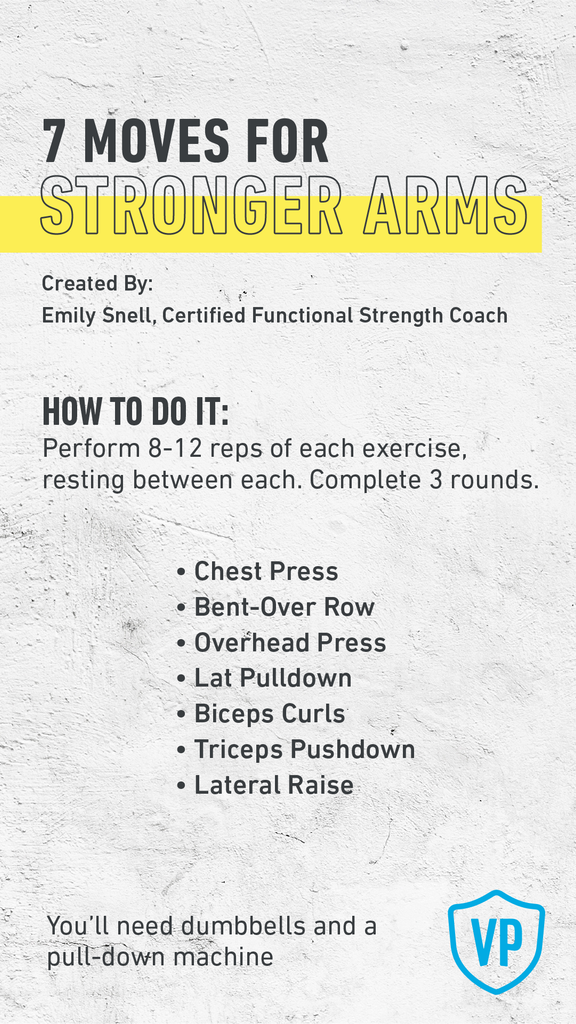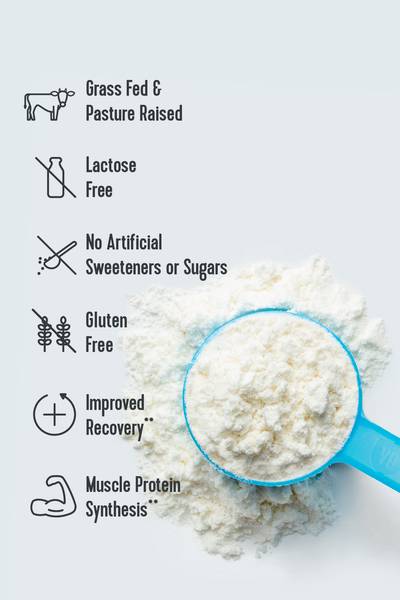As a Certified Strength and Conditioning Specialist, mobility expert and Pregnancy and Postpartum Corrective Exercise Specialist Emily Snellpractically lives in fitness studios.
And because she's surrounded by people who want to look and feel their best, the trainer is a pro at developing new workouts targeting different body parts, like arms, core, legs and glutes. So, Snell created this Lively exclusive workout for anyone wondering how to get stronger arms.
If you have had the pleasure of taking one of Snell's classes or even just quickly scanned her Instagram, you know she's strong (and a total badass) when it comes to creating and following through with her workouts. So, are you ready to take on the exercise moves she designed for us?
"This one is a bit of a 'bro' workout that's going to give you that upper body pump," says Snell, describing the workout.
Challenge accepted.

How do you strengthen your arms?
If you want to build stronger arms, you'll have to strength train. This isn't to say you can't build arm muscle with body weight — push-ups, triceps dips and plank variations are great moves that will help strengthen your arms. To level up your at-home workouts, you can also incorporate resistance bands.
But if you're looking for major gains, you'll have to add weights too. (New to the gym? These beginner workout tips will help you feel comfortable using weights in no time.)
Related Articles
How Long Does It Take To Get Stronger Arms?
As everything in the fitness world, this depends on your current fitness level, your goals, your training regimen and genetics among other things. Oftentimes, it can take three to six months of consistent strength training and proper diet for you to see results.
How to Get Stronger Arms
Try this workout created by Snell.

How to do it:Perform 8–12 reps of each exercise, resting between each. Complete 3 rounds.
What you need:dumbbells (or barbell) and pull-down machine
Try This 7-Move Arm Workout
Barbell (or Dumbbell) Chest Press
Lie back on bench, neutral spine (slight arch in lower back), pinch shoulder blades together as if you were trying to crush a nut between your shoulder blades. Hands about shoulder width, brace core and take deep breath, lift bar out of rack and lower to your “safe zone” (sternum area, that V between your chest) When lowering the bar think of making an “A” or “arrow head” with your head and elbows vs making a “T” and having elbows flair out at 90degrees. That will place unnecessary strain on the shoulders. Touch chest with bar, push feet through the ground and press the bar to the ceiling. Exhale on the way up.
Dumbbell Bent Over Row
Hold dumbbells by your side, think big chest and shoulders back. Keep your shoulders and scapula locked in place. Hinge at the hips to bend over slightly, brace core to protect your spine. To engage the row, think of pulling your elbows back, like starting a lawn mower vs. pulling straight up like an elevator. Allow arm to swing slightly forward on its natural path to return to start of movement. There should be a good stretch in the lat, not much pressure on the shoulders to lift/row the weight.
Barbell or Dumbbell Overhead Press
Hold dumbbells shoulder-height, palms can face each other (neutral grip) or face forward (standard grip) neutral grip is best for beginners and people with shoulder complications. Forearms should be vertical at bottom of lift, not angled. Contract glutes, brace core, deep breath and press the dumbbells overhead. If looking at the top of lift from the side (arms extended overhead), your arms should aligned with your ears (ears should be hidden behind arms from the side view).
Lat Pulldown
Sit on bench, grab handle (overhand or underhand grip), hands placed at or around shoulder-width. Think big chest and shoulders back, scapula should be set back and locked in place. This will place the tension on the lats where we want it. Brace core, deep breath and initiate pull from the scapula and think of a string pulling your elbows down and slightly backwards. Lower bar to around chin level or whatever your mobility allows. Squeeze shoulder blades together at bottom of lift. Return to start. Keep shoulders set back and tension on the lats.
Biceps Curl
Grip one dumbbell in each hand. Perform a biceps curl to bring weights up to shoulders, keeping elbows at your sides. Avoid swinging the weights on the way up. Pause, then lower the dumbbells slowly to return to starting position
Triceps Pushdown
Step up to cable pulley machine. You can use a variety of handles from the rope, angled bar, straight bar or whatever else feels good and places tension on the tricep. You can use an underhand or overhand grip (both work triceps, just different parts). Overhand will be easier and allows you to use a heavier weight. Big chest, shoulders back, contract glutes, brace core, deep breath. Push handle straight down by straightening your arms and flexing your tricep. Return to starting position slowly.
Lateral Raise
Hold dumbbells by your side, palms facing each other. Big chest and shoulders back and slight forward lean. Squeeze glutes, brace core, deep breath and raise the dumbbells straight out to the side until you reach shoulder height or make a “T” with your arms and body. At the top of lift, slightly angle your hand so your pinky is higher than your thumb. (Think of pouring tea). Lower weights slowly. Avoid swinging and swaying when lifting the weights.
Vital Note: This article has been made available for informational and educational purposes only. It is not intended to be a substitute for professional medical advice, diagnosis, or treatment. Always seek the advice of your physician or another qualified health provider with any questions you may have regarding a medical condition. Your licensed healthcare professional can best provide you with the diagnosis and treatment of any medical condition and assist you as well in deciding whether a dietary supplement will be a helpful addition to your regimen.















